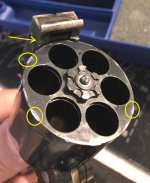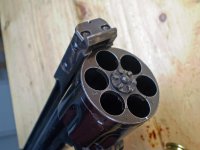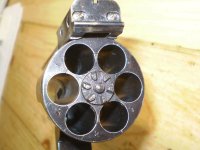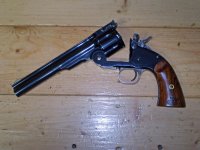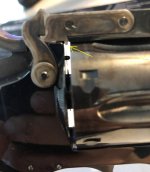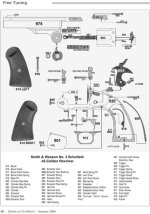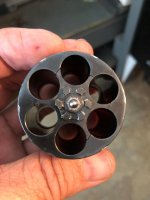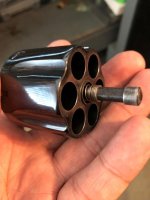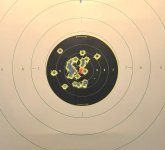My first guess is that the extractor rod which is simply screwed into the back end of the extractor is too long by a few .000
Perhaps it's backed out a little, or the parts are just a touch to long.
The extractor rod with the extractor attached is pushed upward (to eject the casings) as the revolver is opened.
The 'extractor cam' does that pushing. That part is located in the rounded portion of the frame at the front and is the common part in most every top break..that round washer like part with the arm like projection.
As the extractor rod w/ extractor attached are pushed upwards as the bbl is opened, the bbl reached a limit of travel (full open).
**IF the extractor rod w/ extractor reaches IT'S full limit of travel before that..and that would be to be stopped by those fragile cylinder stop tabs one of which is already broken,,,,then the extractor cam continues to push hard on the extractor rod and extractor against those tabs.
That extended motion would IMO lead to breaking the tab(s) and/or imprinting what is left of them into the rear edge of the cylinder itself.
Clean up the marks and they'll just reappear. The source is still there. Something is pushing the cylinder hard with the extractor already pushed out to it's limit in the ejection cycle.
Before you disasemble anything,,open the revolver, tease the extractor out and back as far as you can w/o it snapping back in the cylinder.
When the extractor is at it's full out/extended position,,,note if the cylinder itself is now pushed hard up against that small bbl latch tab(s).
It should NOT be.
At most when ejecting empty fired rounds some drag from the brass cases will push the cylinder back against those tabs.
But the mechanical push against the extractor rod and extractor should NOT be transfered to the cylinder so that it can then push on those tabs.
I think that is what is breaking them and marking the cylinder.
Remove the bbl latch,,if they are anything like the orig, the rear screw should only need a 1/2 turn loosened.
Then loosen the front screw.
You should be able to tilt the latch upwards to clear the small tab(s) from the cylinder edge and pull the cylinder itself right off it's axel pin.
If it won't tilt with a 1/2 turn on the rear screw,,then just remove the rear screw. The orig ones had a 1/2dia cut thru the body of the rear screw to allow disassembly w/o full removal of the screw(s).
The extractor rod hanging out the back of the cylinder should have a hole thru it. With some empty cases in the chambers, put a punch thru the hole and unscrew RH the extractor rod from the extractor and pull the parts out. A coil spring will be around the assembly and that'll slide right off.
Make note of wether the thing unscrews with any force needed or wether it's loosely assembled.
Take a look at end of the rod where the cam pushes on it. Does it look deformed a bit and heavily burnished like the cam arm was over stressed iin pushing on it..
Perhaps a slight shortening of the end of the extractor rod would do it, or maybe just tightening the assembly.
The orig bbl latch could be laser or tig welded and reshaped w/o a lot of fanfare to complete the repair.
The newer Schofield may have some modern internal refinements and differences I'm not aware of,,I've never had one apart. But this is what I recall of the orig pistol and I think may be the problem

